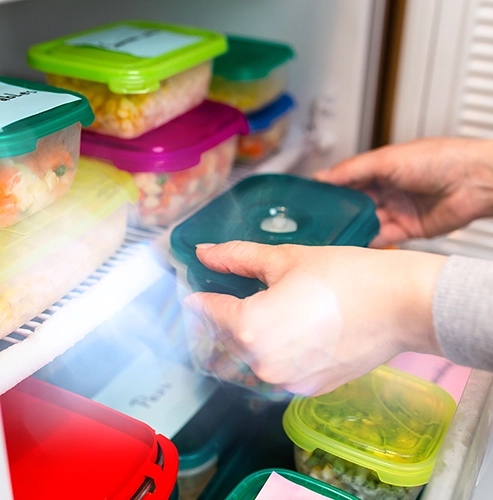Essential Guide: Do You Freeze Your Meal Prep?
Ready to talk about meal prep? Here’s the scoop: You probably don’t need to freeze your weekly meal prep if you’re cooking for just the week ahead. Freezing can be a hassle and let’s face it, not all dishes take kindly to the big chill.
Stashing your meals in the fridge might just be the best way to keep meal prepping simple and tasty. Let’s dig into how you can keep your meal prep fresh without freezing!

The Short Answer – No Freezer Required!
Meal prep can sometimes feel like you’re running a small-scale restaurant out of your kitchen, right? But here’s a little secret: when you’re only cooking say, 3 to 5 days of make-ahead meals—you can skip the freezer drama.
Yep, your trusty fridge is more than up to the task. Here’s why keeping things refrigerated and not frozen, is the way to go:
Texture and Taste:
Freezing might seem like a good idea until you thaw your meal prep and it’s more ice crystal than cheesy delight. Popping your meal prep in the fridge, however, keeps the textures and flavors intact. That means your pasta dishes can stay perfectly al dente and your veggies keep that satisfying crunch.
Convenience:
Forget the freeze-thaw cycle. Who wants to remember to defrost lunch or dinner? With refrigeration, you just reach in, grab what you need, and you’re set. Some meals might need a quick zap in the microwave or a simple serve-as-is salad, either way, your meals are ready when you are.
Freshness:
Keeping your meals in the fridge means they stay fresher longer, without the risk of freezer burn or the sad, soggy aftermath. No frost, no fuss, just delicious, ready-to-go meals right at your fingertips. This approach not only makes your weekly meal management a breeze but also keeps your dishes tasting like they were made just moments ago.

Keeping It Fresh – Tips for Refrigeration
Once you decide to give your freezer a break and stick with the fridge for your meal prep, it’s all about making sure those meals stay as fresh on day five as they did on day one. Here’s how to keep your fridge-friendly meals fresh and tasty. Ensure that you’re using safest way to store your meals by investing in good quality, airtight containers that seal in freshness. It’s also a great idea to plan your meals around what you’ve recently purchased at the grocery store, prioritizing ingredients that spoil faster. This approach not only maximizes the taste but also the nutritional value of your meals:
Pick Your Recipes Wisely:
Not all dishes are created equal when it comes to sitting pretty in the fridge. Hearty soups, robust stews, and marinated proteins love a few days of chilling out, letting flavors meld beautifully over time. Pasta salads (slightly undercooked) can also defrost well, as do roasted veggies. On the other hand, keep delicate items like leafy greens and vegetables that change texture separate from the rest of your meal prep in the fridge like. Add these to the rest of the meal when you are ready to eat.
Use An Airtight Container:
If freshness is your goal, airtight containers are what you need. They’re the secret to warding off food spoilage and keeping unwanted fridge smells at bay.
Glass containers? They’re a win for seeing exactly what you’ve got and how much, but high-quality plastic can do the trick too. Make sure they’re clean, seal well, and you’re good to go.
![M MCIRCO [5-Pack,36 Oz] Glass Meal Prep Containers 2 Compartments Portion Control with Upgraded Snap Locking Lids Glass Food Storage Containers, Microwave, Oven, Freezer and Dishwasher (4.5 Cups)](https://m.media-amazon.com/images/I/51Fn7jkXz2L._SL500_.jpg)



As an Amazon Affiliate, we earn from qualifying purchases at no additional cost to our readers.
Smart Fridge Organization:
Think of your fridge like a little ecosystem. To keep it running smoothly, place your meals where they fit best:
- Top shelves are great for drinks and ready-to-eat foods (like your prepped meals ready for lunch or dinner time).
- Lower shelves are ideal for raw ingredients that need cooking.
- Crisper drawers are perfect for fresh produce you plan to use within a couple of days.
Keep cooked foods and raw ingredients separate to avoid any cross-contamination. And don’t pack things too tightly; air circulation is key to maintaining an even temperature throughout.
The Long Answer – When Freezer Prep Makes Sense
Alright, we’ve sung the praises of the fridge, but sometimes freezing just makes sense, especially if you’re juggling a busy schedule or planning for an extended period away from the kitchen, or want to build your freezer stash with meals (our favorite!). Here’s when to consider giving your meals the deep freeze treatment, and how to do it right:
Perfect Scenarios for Freezing:
If you’re looking at being out of town for a while or you’ve gone on a cooking spree and have more food than you can eat in a week, the freezer can save your day. It’s also a fantastic option for those times you find a killer sale on bulk ingredients and want to capitalize on the savings. We like turning ingredients into meals in this case but sometimes you just need to freeze your ingredients to stretch them out and that’s okay too!
Pick the Right Recipes (Freezer-Friendly Meals):
Some dishes freeze better than others. Think about hearty, saucy meals like lasagna, stews, chili, or soup. These foods not only withstand freezing well but often taste better after the flavors meld in their frozen state. Foods with high moisture content, however, such as dishes with fresh, uncooked veggies or creamy sauces, might not fare as well and the texture will change.
Prep for the Freezer:
To ensure your food freezes and thaws beautifully, here’s what to do:
Cool Your Meals:
Always let your food cool completely before freezing. Hot food can raise the freezer’s temperature, causing surrounding frozen items to partially thaw and refreeze, which can alter texture and taste.
Portion Control:
Freeze meals in the portion sizes you’ll want to eat later to avoid thawing more than you need. This is where Souper Cubes come in handy! They’re perfect for freezing your meal preps in ideal portions, making it super easy to pop out a single serving (or multiple) for reheating without defrosting the whole batch. They come in different sizes to make this easy to build your freezer stash of meals.
Label Love:
Be sure to label your meals with the freezing date and any reheating instructions. This will help keep track of what you’ve got and ensure everything is enjoyed before the freezer burn sets in. Although technically nothing can go “bad” when frozen the quality and taste can diminish overtime if you leave your meals frozen for too long.
By understanding which meals you should freeze and not freeze, you can extend the life of your meal preps without sacrificing quality. Make sure you are freezing room temperature food in a single layer in your freezer with enough space to breath. Freezing is about food preservation, less food waste, and making your future self a little happier and your meals a bit more convenient.
Common Misconceptions About Meal Prep and Freezer Meals
When it comes to freezing your meals, there’s a lot of myths that need some defrosting. From health concerns to freezing faux pas, let’s clear up a few of the most common misconceptions and set the record straight:
Myth 1: Freezing Meals Reduces Their Nutritional Value
One of the biggest freezer myths is that frozen meals are somehow less nutritious than their fresh counterparts. Let’s bust this icy tale! Freezing actually preserves the nutritional content of your meals, locking in vitamins and minerals at their peak.
As long as you’re cooking healthy meals to begin with, freezing them won’t diminish their goodness. It’s a great strategy to keep your diet balanced and ensure you always have something good and ready to go.
Myth 2: All Foods Freeze Well
Not all heroes wear capes, and not all foods freeze well. Understanding the nature of what goes into your freezer can save you from culinary disappointment. High water content foods, like lettuce, cucumber, and fresh fruits can become mushy and unappetizing when frozen and thawed because ice crystals rupture their cell walls.
Cream-based sauces and dressings can separate and grainy textures can develop in certain dairy products. Stick to freezing meals that are meant for the freezer like soups, stews, pasta sauce, and sauces.
Myth 3: Freezing Food Is Complicated
Many think freezing food requires special equipment or tricky techniques. Not so! Freezing is actually one of the easiest methods of food preservation. I used to hate freezing my meals until I found Souper Cubes in 2019. This little kitchen tool has been a lifesaver for me to freeze my meals without it all going to waste. The idea of individual portions or individual pieces of a meal that you can pull out frozen for dinner is so helpful instead of having to defrost an entire container of soup!
With simple tools like freezer bags, resealable crockpot meals, airtight containers, or the handy Souper Cubes, you can freeze most meals quickly and easily. Just cool your meals, package them properly, label, and freeze. The trick is in selecting the right meals to freeze and knowing the best ways to thaw and reheat them to maintain the best quality.
Understanding What Doesn’t Freeze Well
It’s also useful to know why certain foods don’t fare well in the freezer. Foods with high moisture content can turn soggy upon reheating due to the ice crystals formed during freezing, which break down the structure of the food. Delicate foods like fresh greens, soft cheeses, and creamy preparations might not recover their original texture post-freeze. If you don’t mind a texture change of your food these are fine to do but this is a turn off for most people who are looking to preserve the life of their meals.
Keep in mind that many fresh ingredients can be added when reheating meals to revive that just-cooked flavor and texture. We like this strategy for example: freezing spaghetti sauce for later when you are batch cooking, but then making the pasta fresh the day you a ready to eat the meal! It’s a great freezer stash shortcut.
Knowing what to freeze means you’ll always have something delicious and ready to enjoy right at home.

Fridge or Freezer Meal Prep? Your Kitchen, Your Rules!
So, what’s the verdict on meal prep food? Whether you’re banking on the fridge for the week’s eats or planning ahead with the freezer, the choice is yours. We say use your fridge to keep everything from your Sunday prep session as fresh as the day you made them with proper storage.
For meals that you just didn’t get to in the week or you want to stretch out your cooking efforts for another week the freezer is the way to go. Tools like Souper Cubes are a game changer and make this even easier, letting you stash perfectly portioned individual meals without any fuss.
Experiment with both, see what works with your lifestyle, and fine-tune as you go. Meal prep is all about finding your groove and making your kitchen hustle work for you with easy meals, keeping it as simple and fun as possible.










